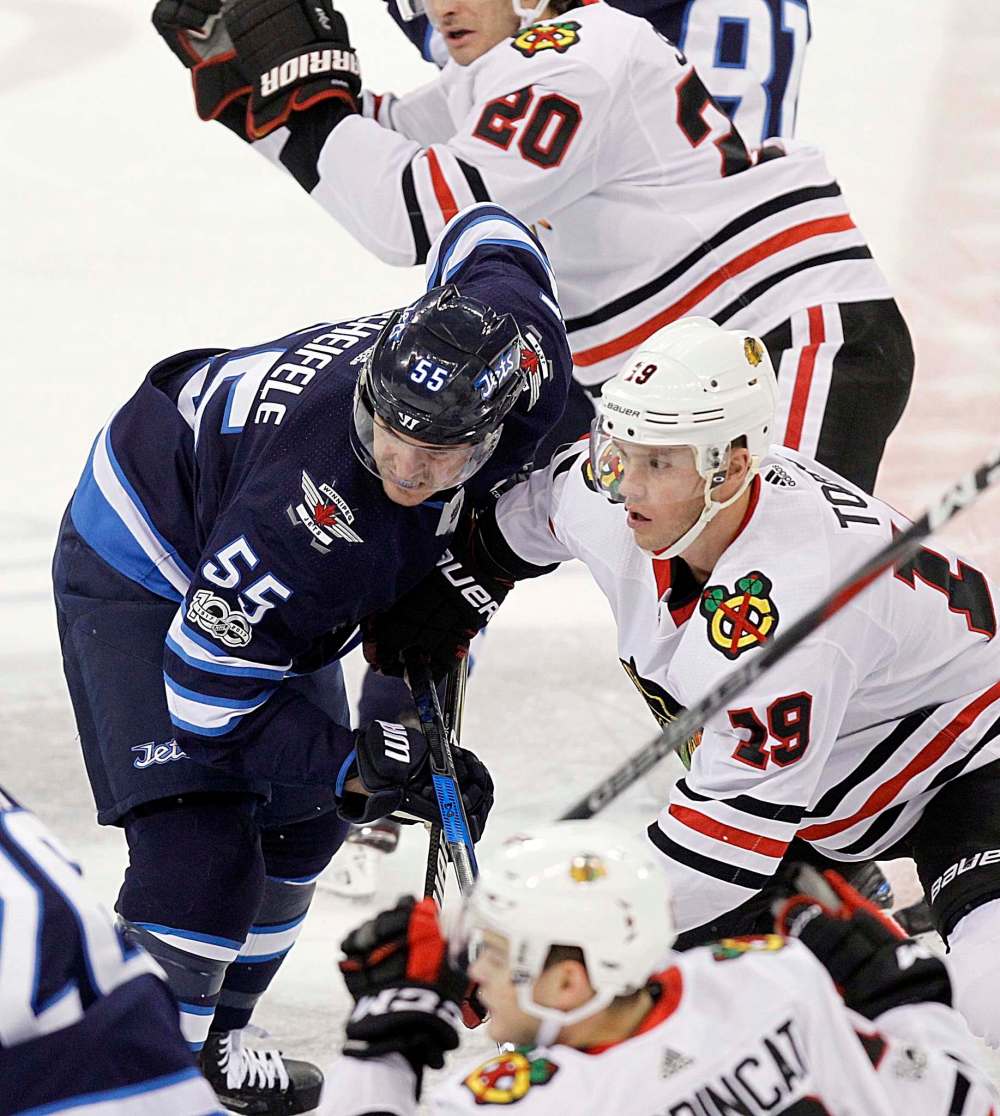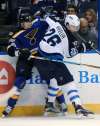Knowing where to draw a line in the ice
Faceoff stats improve for Jets this season
Advertisement
Read this article for free:
or
Already have an account? Log in here »
To continue reading, please subscribe:
Monthly Digital Subscription
$19 $0 for the first 4 weeks*
- Enjoy unlimited reading on winnipegfreepress.com
- Read the E-Edition, our digital replica newspaper
- Access News Break, our award-winning app
- Play interactive puzzles
*No charge for 4 weeks then billed as $19 every four weeks (new subscribers and qualified returning subscribers only). Cancel anytime.
Read unlimited articles for free today:
or
Already have an account? Log in here »
Hey there, time traveller!
This article was published 13/12/2017 (2325 days ago), so information in it may no longer be current.
It was around this time last season that Winnipeg Jets centreman Adam Lowry was lamenting some of the inconsistencies taking place inside NHL faceoff circles.
The Jets were in Nashville at the time, riding a four-game losing streak that would ultimately extend to five games, following a 5-1 loss to the Predators. The team’s record reflected the skid, with the Jets near the bottom of the Central Division at 9-12-2.
But it was another dismal statistic that seemed worthy of discussion that day. Lowry wanted to vent about the process in determining the winner of a faceoff — something he said seemed to vary from night to night, building to building. At the time, the Jets were last in the NHL at the dot, with a success rate of just 44.1 per cent.

Fast-forward a year to Thursday, and the fourth-year Jet remained true to his earlier assessment.
“I still think the numbers are a bit skewed,” he said following his team’s morning skate at Bell MTS Place.
Though Lowry’s beef remains intact, much has changed for the Jets since then — inside the faceoff circle and out.
Winnipeg (18-8-5) is in third place in the Central Division and has won seven straight games at home. Heading into Thursday night’s game against the Chicago Blackhawks, the Jets were clicking at 58.3 per cent on faceoffs, third best in the NHL.
Still, a major jump this year mattered little to Lowry.
“Sometimes you get the favourable bounces at home, but we keep track of our own tallies in here,” he said.
Through their search for answers and options to improve the team’s collective faceoff percentage, head coach Paul Maurice credited a number of different reasons for why the Jets are off to a better start. He reasoned the Jets — though still among the youngest teams in the NHL — are another year older and, therefore, one year stronger and wiser.
Lowry, though, carrying a big load at 6-5 and 210 pounds, is only 24. He finished last season winning 50.8 per cent of his draws. This season, he’s climbed to 54.6 per cent through 22 games. Mark Scheifele, also 24, has improved the most, jumping from 43.5 per cent to 52.2 per cent — a vast improvement despite battling some of the toughest centres in the league every game.
Another reason Maurice believes the Jets are having success is because of the changes to the rules this year — or, rather, the enforcement of existing rules that had fallen by the wayside over time.
The NHL made the decision this year to clamp down on how linesmen called faceoff infractions. The point was to prevent some players from taking liberties in the circle — “cheating” as most around the league call it — by lining up any way they choose. For years, some players — “Anyone over 30 or if you had a few Stanley Cup rings, you never got your stick off your shin pads,” said Maurice — were rarely called for how they lined up.
Under the new enforcement of the rules, all players taking a draw must line up their feet within the limits of the markings by the dot, and not on the inside or even touching the lines. Also, depending on where the faceoff is, the player on his side of the red line must place his stick down first (for centre-ice faceoffs, the visiting centre must postion his stick first). The only new rule is that players are no longer able to glove the puck to help win a draw.
Needless to say, the changes have come with mixed reviews.
“I like the old rules better,” said Matt Hendricks, the 36-year-old, 10-year NHL veteran centre the Jets added in the off-season, in part, to boost their faceoff success. “I liked to be able to take over a dot, get my head over the dot and kind of bully my way in there. Now, with the lines the way they are and your toes have to be behind them, I’m not big enough to get over to where I wanted to be. It’s a balancing act.”
Hendricks and Bryan Little are the two veteran centres for the Jets. Little, 30, seems unaffected by the recent changes — consistent as ever, improving from 55.6 to 57 per cent (a team high). Hendricks’ struggles have shown in his numbers.
He’s down seven per cent from last season when he played for the Edmonton Oilers, dropping from 56.9 to 49.7 per cent with the Jets.
Though he said he’s working hard to improve those numbers, he said the rules have favoured players such as Scheifele.
“They allow for less scrums. It’s more of a skill battle now,” Scheifele said, adding he worked on faceoffs in the summer with Adam Oates, who also suggested he change the curve of his stick.
“You used to have guys who would have their whole skate over the line or guys wouldn’t be dropping their sticks. The new rules have made it more of a fair battle.”
Then there’s the fact the Jets have a number of backup options for when players get kicked out of the faceoff circle. Andrew Copp and Mathieu Perreault are natural centres currently playing on the wing. Captain Blake Wheeler, who played two games at centre last season when injuries struck the team, and Shawn Matthias, when in the lineup, are also available to fill in.
“It helps, certainly. Mark seems to get kicked out four or five times a game,” Wheeler said. “The more guys who can do it is huge.”
Perhaps the biggest impact has come from assistant coach Todd Woodcroft. When Woodcroft was hired, he joined a Jets team that finished the 2015-16 season 28th in faceoffs.
Despite being brought in with an agenda to change how the Jets approached faceoffs, he would see only a marginal improvement last season, as the Jets climbed from 46.6 per cent as a team to 48.5 — good enough for 21st in the NHL. But with another season working with much of the same personnel, the hard work has finally started to pay off.
“I’ve never had a guy like this, that does this as a big part of what he does,” Maurice said. “He puts an awful lot of time, hours per day, into evaluating.”
Woodcroft spends around three hours a day putting together a scouting package for each game. For every team the Jets play, Woodcroft provides a full report on each opponent — identifying the tendencies of every player that takes a faceoff, in every area of the ice. Because he keeps stats on every player with the Jets, he’ll also send personal reports of each player. Both are sent daily through email.
“He keeps track of every situation: power play, penalty kill, 4-on-4, all situations,” Hendricks said. “It’s nice when those numbers are in front of you and you get to see where you need to improve and where you’re doing well. Without his work, I don’t think we’d be where we are right now.”
The advantages of winning faceoffs seem obvious. When you win them, you earn possession of the puck. And when you have the puck, you can create scoring chances. Many argue when they’re most important is during special-teams situations, when losing or winning a draw can often mean the difference between scoring a goal or being scored upon.
Still, it’s impossible to quantify just how important faceoffs are to winning. After all, five of the top-10 teams in faceoff percentage rank in the bottom-third in the NHL, including two of the three worst teams in the NHL in the Ottawa Senators (29th) and Buffalo Sabres (30th).
“It doesn’t correlate to winning,” Maurice said. “It’s psychological more than it is statistical evidence of winning.”
jeff.hamilton@freepress.mb.caTwitter: @jeffkhamilton

Jeff Hamilton
Multimedia producer
After a slew of injuries playing hockey that included breaks to the wrist, arm, and collar bone; a tear of the medial collateral ligament in both knees; as well as a collapsed lung, Jeff figured it was a good idea to take his interest in sports off the ice and in to the classroom.







